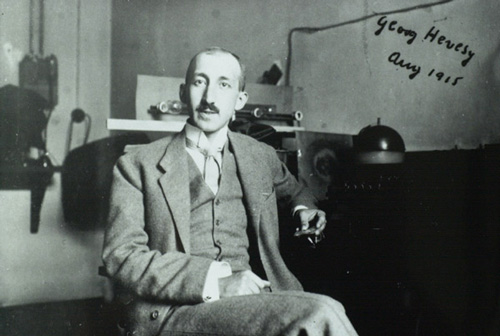1913 : First use of radioactive tracers
The discovery of the radioactive indicators, the name then given to the use of radioactive atoms as chemical tracers, dates back to the 1910s.
n 1897, Marie Curie had proved that by detecting radiation one could identify radioactive elements that were undetectable by conventional chemical methods. A second step was achieved in 1913, when Georg de Hévesy had the idea of tracking a chemical element by adding an infinitesimal quantity of radioactive isotope to it.

Georg de Hevesy
George de Hevesy at the Radium Institute in Vienna in 1915. Hevesy received the Nobel Prize in Chemistry in 1943 for his work on the use of radioactive isotopes as tracers. With the German physicist Frédéric Paneth, he carried out the first experiment with radiotracers at the Institute in 1913. The year this photograph was taken, he was enlisted in the Austro-Hungarian army.
© Source: Central Library for Physics, Vienna
The name of Georg de Hevesy is associated with the beginnings of the use of radioactive indicators in chemistry, biology and radiodiagnosis in medicine. At the Manchester University, Rutherford instructs the newly arrived young Austro-Hungarian chemist to separate Radium-D from lead. Rutherford had just acquired a considerable quantity of Radium D, a valuable radioactive derivative of radium which he hoped to use. This radium D was mixed with a large amount of lead, which made it extremely difficult to study its radiations.
Today we know that the radium-D of the 1910s was a lead isotope, lead-210. Hevesy therefore could not separate lead from lead. From his unsuccessful separation efforts, Hevesy derived the idea of using radium-D as a “radioactive indicator” to study the properties of lead. In 1913 at the Radium Institute in Vienna, returning from his stay in Rutherford’s laboratory, the Hungarian chemist developed with Friedrich Paneth a method using radioisotopes as tracers in chemical reactions.
From its observaton that chemistry was powerless to differentiate lead from radium-D, Hevesy thought that biological systems would not be able to do this either. He used radium-D, this radioactive derivative of radium, actually an isotope of lead, to explore its distribution in plants. He soaked the roots of certain plants in a solution of lead nitrate and radium D, then, measuring the acquired radioactivity, he demonstrated that most of the lead was going in the roots.
An anecdote says that Hevesy, who lived in a boarding house, had the impression that its land lady was reserving dishes leftover by accommodating them in a new way. He threw a handful of atoms of radium D and lead into the remains of a stew. He was thus able to follow the successive transformations of the stew into shepherd’s pie, then into a soup! This ingenious application of the isotopic method earned him his dismissal from the pension.
Far from the anecdote, it was in 1924 that the first use of indicators in humans was made. Blumgart and Weiss, two American doctors, measured the speed of blood circulation between the two arms by injecting radium C (Bismuth-214) into one arm, as well as variations of this speed in cardiac patients.
What then hinders the development of this indicator method is the small number of available natural radioelements! But in 1934, Irène and Frédéric Joliot-Curie demonstrated the possibility of creating radioactive isotopes of any element on demand, whereas until then it had been necessary to use the rare descendants of uranium and thorium.
Y.Grall
Learn more :
1934 : Discovery of artificial radioactivity